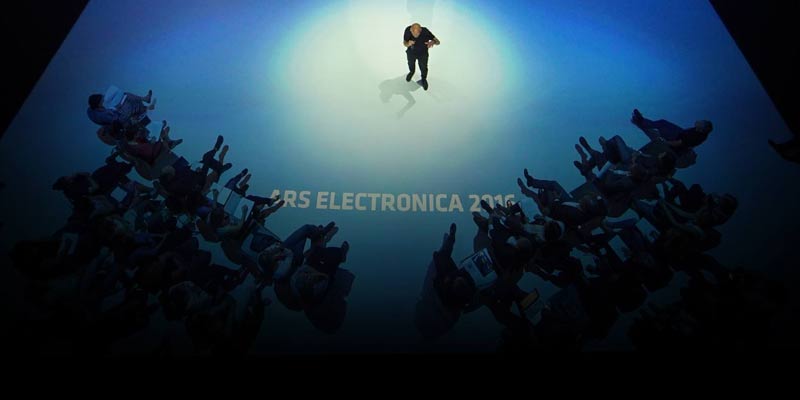Ars Electronica Futurelab Developed RoboLab for Vienna’s Museum of Technology
(Linz, Vienna / December 10, 2012) Arousing keen interest in technology, critically scrutinizing its social significance, and generally nurturing knowledge and creativity—these aims are shared by Technisches Museum Wien and Ars Electronica Linz, and are thus a solid basis for the intensive process of exchange the two institutions have been involved in for years now. This collaborative relationship will now make its public debut in the form of “Robots: Machine or Humanoid?,” the new exhibition at the Technisches Museum. Claudia Schmied, Austrian Federal Minister for Education, the Arts and Culture, will preside over the opening on December 13, 2012 at 6:30 PM. The show’s core installation was developed by the Ars Electronica Futurelab: RoboLab featuring interactive installations having to do with seeing machines, sensor engineering, programming, and artificial intelligence. The pedagogical mission: taking a fun approach to imparting insights into technology. This exhibition also spotlights the increasing interaction of humans and machines in everyday life. Accompanying the run of “Robots: Machine or Humanoid?” is a series of workshops going into detail about various facets of the subject matter in particular and the field of robotics is general.
Seven Interactive Installations
CodedMaze
An easy-to-learn computer game offers the chance to get hands-on experience programming various types of robots. The object is to navigate a robot through a maze and collect objects along the way, whereby there’s a limit to the number of steps the robot is permitted to take. Programming the robot is done either visually or via punched cards.
Sensor Brix
Sensors are able to measure temperature, humidity, pressure, sound, light, magnetism, acceleration and various chemical properties in their vicinity. This installation illustrates how quickly and efficiently such sensors work.
RobotMe!
“RobotMe!” lets you mix & match images of human body parts with their robotic counterparts. Installation visitors are filmed in an on-site photo booth. A computer then cuts each snapshot up into horizontal strips (head, torso, abdomen/legs) and projects them onto a wall in the space. An interface then lets the installation visitor assemble a new body out of his/her own images (or those of other visitors) and pictures from a gallery of robot components. The file containing the resulting image can then be attached to an e-mail.
RoboZoo
Visitors to “RoboZoo” can put various robots through their paces via tablet computer or remote control unit. Zoo inhabitants include Paro, a baby seal that monitors its surroundings using five computer-controlled sensors, humanoid machines, and units capable of locomotion via spider-like legs and wheels.
Behind the Eye
“Behind the Eye” explains the basic principles of computer vision, and the processing steps performed by hardware and software that make it possible for machines to see. The installation is apportioned among several tablets running software that can digitally register and evaluate colors and shapes including facial features. Here, visitors can directly observe the individual procedures a computer-controlled system has to perform in order to perceive the world, whereby it turns out that things humans take for granted actually constitute a sequence of complex analytical steps that can deliver truly mind-boggling results nowadays.
Catch me if you can!
Installation visitors steer a tiny remote-controlled robot on wheels. The object is to avoid capture by an industrial robot equipped with a camera tracking system and a magnetic arm. If the player’s too slow, it’s GAME OVER and RESTART. There are several levels, whereby the industrial robot gets progressively faster. A monitor displays the current score and makes the tracking process more transparent and easily understandable.
Nyoro Nyoro
Here, installation visitors use variously colored balls to interact with a robot equipped with camera tracking capabilities. The balls evoke a variety of emotional reactions on the part of the robot, which take the form of arm movements accompanied by corresponding sounds. Visitors determine via touchscreen how Nyoro Nyoro behaves in response to, say, the blue balls: happy, sad, angry, curious or anxious. This installation as well is designed to illustrate the connection between digital perception and carrying out an action.
Ars Electronica Futurelab
The Ars Electronica Futurelab, a division of Ars Electronica Linz, was set up in 1994. Its staff conceives, plans and carries out technological research and media art projects commissioned by clients worldwide. The Futurelab works both independently and as a member of international joint ventures. It was recently named one of the world’s Top 10 Media Labs by Wired Magazine. The Futurelab’s interdisciplinary teams are made up of a variable roster of computer artists, computer scientists, interaction designers, physicists, media & product designers, architects, game developers, telematics engineers, media psychologists, art historians, and scholars in cultural studies and communications. The list of world-renowned institutions with which the Ars Electronica Futurelab has conducted research projects over the years includes Honda Robotics, MIT Boston and ATR in Japan. In addition to its R&D expertise in the robotics field, the Futurelab’s proven know-how in the design of educational exhibitions has gone into the configuration of the new RoboLab.
press release Ars Electronica Futurelab Developed Robo for Vienna’s Museum of Technology / PDF
Please also visit our Ars Electronica Blog where you can also find an entry on our new RoboLab at the Technical Museum in Vienna, along with photos and images of all the installations.
http://www.flickr.com/photos/arselectronica/8252755846/
Sensor Brix / APA, Thomas Preiss / Printversion / Album
http://www.flickr.com/photos/arselectronica/8252413954/
RoboZoo / Michael Kaczorowski / Printversion / Album

